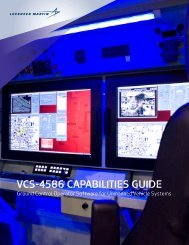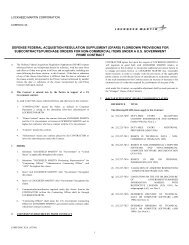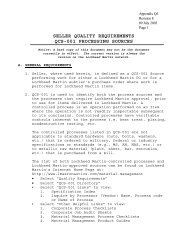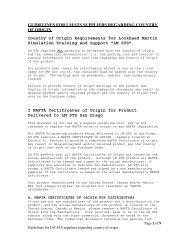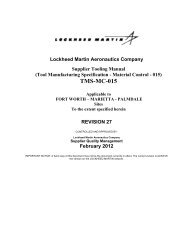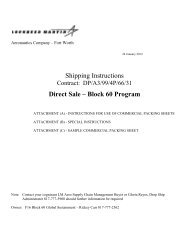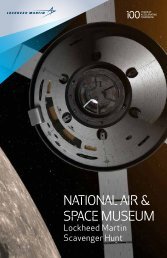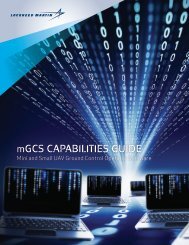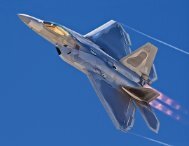Highlights Brochure - Lockheed Martin
Highlights Brochure - Lockheed Martin
Highlights Brochure - Lockheed Martin
Create successful ePaper yourself
Turn your PDF publications into a flip-book with our unique Google optimized e-Paper software.
<strong>Highlights</strong><br />
Space Systems Company<br />
Spring 2013
LONG STRIDES<br />
Forty-four years ago, when astronaut Neil Armstrong became<br />
the first person to set foot on the moon, he did so on the<br />
Mare Tranquillitatis, or “Sea of Tranquility.” But the months,<br />
days, and minutes leading up to that historic milestone were<br />
anything but tranquil.<br />
In the final seconds of the lunar module’s descent, its alarms<br />
were sounding and its fuel tank was 30 seconds shy of empty.<br />
When Armstrong at last radioed Houston Mission Control the<br />
words, “The Eagle has landed,” the ecstatic controller replied,<br />
“You got a bunch of guys about to turn blue. We’re breathing<br />
again!” In that moment—despite enormous technical pressures, unabated expectations, and<br />
a looming economic recession—a decade of tireless effort from thousands of civilian and<br />
government workers came to spectacular fruition.<br />
Two generations later, that can-do spirit still thrives at <strong>Lockheed</strong> <strong>Martin</strong> Space Systems<br />
Company, as 2012 again delivered first-of-its-kind technical achievements in a challenging<br />
environment much like the one we saw in 1969. By focusing on performance, innovation,<br />
and smart affordability, we continue to support defining moments and deliver the best solutions<br />
for our customers, reducing costs while developing next-generation technologies and<br />
ensuring the resiliency of space mission capabilities. From the depths of the oceans to the<br />
outer reaches of the universe, we are committed to providing end-to-end mission solutions<br />
that meet our customers’ vital needs.<br />
As <strong>Lockheed</strong> <strong>Martin</strong> marks its centennial and we honor pioneers like Armstrong, we also<br />
honor you, the customers we are privileged to serve. Ours is a partnership of dreamers and<br />
doers, thinkers and tinkerers, pioneers and patriots.<br />
When President John F. Kennedy issued the challenge in 1961 to take bold new steps in<br />
the exploration of space, he called for “longer strides” from all of us. This year’s edition of<br />
<strong>Highlights</strong> reports on the astounding achievements in 2012 and comes to you with our pledge<br />
to continue taking ever-longer strides right alongside you in the next 100 years.<br />
Table of Contents<br />
Page<br />
Centennial Overview 2<br />
Strategic and Missile Defense Systems 4<br />
Military Space 8<br />
Civil Space 12<br />
Commercial Ventures 16<br />
Special Programs 20<br />
Advanced Technology Center 22<br />
Community Relations 26<br />
Richard Ambrose<br />
Executive Vice President, Space Systems Company
100<br />
Y E A R S O F<br />
A C C E L E R A T I N G<br />
T O M O R R O W<br />
“Flying has no barriers.” - Allan <strong>Lockheed</strong><br />
“Raise heaven and earth, and never stop until you have produced<br />
the thing you set out to make.” - Glenn L. <strong>Martin</strong><br />
MUCH HAS CHANGED IN 100 YEARS.<br />
In 1912, when Glenn L. <strong>Martin</strong> and Allan and Malcolm<br />
<strong>Lockheed</strong> founded the companies that would become <strong>Lockheed</strong><br />
<strong>Martin</strong>, the world was a different place.<br />
Less than 10 percent of American homes had a telephone.<br />
There were only 141 miles of paved roads in the<br />
United States. And, the fastest airplanes couldn’t outrun a<br />
current day sedan.<br />
<strong>Martin</strong> and the <strong>Lockheed</strong> brothers knew they were on<br />
the cusp of an era of great change, driven by amazing tech-<br />
A CENTURY LATER, THAT PURPOSE ENDURES.<br />
nological advancements. “I expect to see the time when<br />
aviation will be the safest means of transportation… and the<br />
cheapest, and I’m not going to have long white whiskers<br />
when that happens,” said Allan <strong>Lockheed</strong>.<br />
Our founders shared a gift for looking beyond the<br />
obstacles of today to the promise of a brighter tomorrow.<br />
They instilled in their companies the unwavering purpose<br />
to help customers rise to the challenge of tomorrow through<br />
game-changing innovation and breakthrough performance.<br />
Today, the men and women of <strong>Lockheed</strong> <strong>Martin</strong> are<br />
united by the purpose and visions of Glenn L. <strong>Martin</strong> and the<br />
<strong>Lockheed</strong> brothers.<br />
From World War to Cold War to War on Terror, from<br />
Industrial Age to Space Age to Information Age, we’re proud<br />
to have stood shoulder-to-shoulder with our customers, helping<br />
them achieve things once deemed impossible.<br />
The imposing Titan missile. The amazing Hubble telescope.<br />
The Space Shuttle’s powerful external tank, and the<br />
Space Station’s majestic solar arrays. Whatever the challenge,<br />
we’ve not only envisioned the future, but created it at<br />
a pace our customers need and at the value they demand.<br />
Now, we’re ready to help take on the challenges of the<br />
next 100 years. From forecasting the weather to protecting<br />
our country, from the depths of the sea to the outer reaches<br />
of space, we’re already envisioning a brighter tomorrow and<br />
helping our customers accelerate it.<br />
GAMBIT AND HEXAGON 1963<br />
During 2012 the National Reconnaissance Office (NRO) declassified<br />
two programs, Gambit and Hexagon, pioneered by <strong>Lockheed</strong> <strong>Martin</strong><br />
more than half a century ago.<br />
Gambit and Hexagon followed Corona, the nation’s first photo reconnaissance<br />
satellite system to return an image from space successfully.<br />
The first Gambit system was equipped with a 77-inch<br />
focal length camera system. It was launched in 1966<br />
and provided space-based surveillance for nearly two<br />
decades. Hexagon was launched in 1971 to improve<br />
upon Corona’s imaging capability.<br />
These search and surveillance satellites provided vital<br />
national security information during the Cold War,<br />
allowing the U.S. to understand the capabilities, intentions,<br />
and advancements of its adversaries from 1960<br />
until 1986. Together the satellites became America’s<br />
essential eyes in space.<br />
2<br />
3
STRATEGIC AND MISSILE<br />
DEFENSE SYSTEMS<br />
Leading the way in<br />
reliability for crucial<br />
missions, <strong>Lockheed</strong><br />
<strong>Martin</strong> designs, produces,<br />
and sustains strategic<br />
missile and missile defense<br />
systems that range from<br />
ballistic missiles, hit-to-kill<br />
interceptors, and target<br />
missiles, to reentry<br />
systems and directed<br />
energy systems.<br />
In the missile defense mission area, the Terminal High Altitude Area<br />
Defense (THAAD) Weapon System achieved several significant milestones in<br />
2012. In February, THAAD received conditional materiel release from the U.S.<br />
Army. This certifies that the two THAAD batteries and their trained soldiers at<br />
Fort Bliss, Texas, are prepared to deploy when directed. In addition, the Army<br />
activated a third battery of THAAD soldiers at Fort Bliss.<br />
In March, <strong>Lockheed</strong> <strong>Martin</strong> received a follow-on contract for Advanced Capability<br />
Development from the Missile Defense Agency to continue development of<br />
the THAAD Weapon System. Congressional notification was achieved in December<br />
for the Qatar request of the U.S. government to procure two THAAD batteries.<br />
Qatar will be the second U.S. ally to procure THAAD. The United Arab Emirates<br />
procured THAAD in 2011.<br />
In its most complex mission to date, THAAD intercepted a medium-range<br />
air-launched ballistic missile target during Flight Test Integrated-01 in October.<br />
The Missile Defense Agency conducted this live-fire flight test at the Reagan Test<br />
Site in the South Pacific. The Aegis Ballistic Missile Defense System, the Patriot<br />
Advanced Capability-3 missile and the THAAD Weapon System successfully<br />
engaged in the first-ever test of all three systems. This test demonstrated the<br />
integrated capabilities of today’s U.S. regional missile defense systems. THAAD<br />
maintains its 100-percent Mission Success record with this 10th successful<br />
intercept. A key element of the nation’s Ballistic Missile Defense System, THAAD<br />
defends the U.S., its deployed and allied forces, population centers, and critical<br />
infrastructure against short- to intermediate-range ballistic missiles.<br />
The Medium Extended Air Defense System (MEADS) battle manager<br />
demonstrated several firsts during 2012. During integration tests in Italy, the<br />
battle manager demonstrated plug-and-fight control over a MEADS radar and<br />
launcher and demonstrated key functionalities, including target acquisition and<br />
track. A MEADS test configuration, including a networked battle manager, successfully<br />
detected, tracked, intercepted, and destroyed an air-breathing target<br />
in an unprecedented 360-degree intercept test at White Sands Missile Range,<br />
N.M. A next-generation, ground-mobile air and missile defense system, MEADS<br />
incorporates 360-degree radars, netted and distributed battle management, easily<br />
transportable launchers, and the hit-to-kill PAC-3 Missile Segment Enhancement<br />
missile.<br />
<strong>Lockheed</strong> <strong>Martin</strong> continues to leverage its satellite and missile defense<br />
domain expertise on the manufacturing and production readiness integrated<br />
systems engineering team for the Missile Defense Agency’s Precision Tracking<br />
Space System (PTSS). PTSS will provide a space-based system for post-boost<br />
through terminal tracking of ballistic missile threats in a global infrastructure.<br />
<strong>Lockheed</strong> <strong>Martin</strong> was awarded a contract in 2011 as part of a team led by Johns<br />
Hopkins University Applied Physics Laboratory.<br />
HOMING<br />
OVERLAY<br />
EXPERIMENT<br />
1984<br />
The U.S. Army’s Homing Overlay<br />
Experiment (HOE) vehicle,<br />
developed by a <strong>Lockheed</strong><br />
<strong>Martin</strong>-led team, destroyed a<br />
test missile above the Pacific<br />
Ocean June 10, 1984, making<br />
history with the world’s first hitto-kill<br />
missile intercept outside<br />
the atmosphere.<br />
This watershed achievement<br />
proved the ability to destroy<br />
enemy missiles with sheer force<br />
of impact, without explosive<br />
warheads on the interceptor, to<br />
minimize lethal effects on the<br />
ground.<br />
THE MISSILE DEFENSE AGENCY’S<br />
THAAD SYSTEM<br />
A Terminal High Altitude Area Defense<br />
(THAAD) interceptor launches from Meck<br />
Island on its way to an intercept of a<br />
medium-range ballistic missile target.<br />
Since the 1980s, the technology<br />
débuted by the Homing Overlay<br />
Experiment has been proven in<br />
more than 70 successful intercepts<br />
in testing and combat.<br />
Systems using hit-to-kill technology<br />
today include the U.S. Aegis<br />
Ballistic Missile Defense, Terminal<br />
High Altitude Area Defense,<br />
Patriot Advanced Capability-3<br />
Missile, and Ground-based Midcourse<br />
Defense, as well as the<br />
multinational Medium Extended<br />
Air Defense System.<br />
4<br />
5
THE MISSILE DEFENSE AGENCY’S<br />
TARGETS & COUNTERMEASURES<br />
An infrared image shows the interception<br />
of a ballistic missile target in 2012,<br />
which brought <strong>Lockheed</strong> <strong>Martin</strong> to a<br />
new record of targets Mission<br />
Success events.<br />
THE AIR FORCE’S MK21 FUZE<br />
<strong>Lockheed</strong> <strong>Martin</strong> is successfully refurbishing<br />
MK21 reentry vehicle fuzes to<br />
extend their service life cost effectively<br />
and preserve Minuteman III Intercontinental<br />
Ballistic Missile flexibility.<br />
In support of missile defense testing, <strong>Lockheed</strong> <strong>Martin</strong>’s<br />
Targets and Countermeasures Program successfully provided<br />
and launched a short-range target missile from a<br />
mobile launch platform in the Missile Defense Agency’s<br />
Flight Test Integrated-01 in October 2012—bringing the<br />
company’s record to 43 successful target missions out of 44<br />
since 1996. This unmatched 98 percent Mission Success<br />
has included unitary and separating targets, spanning land,<br />
sea, and air launches. <strong>Lockheed</strong> <strong>Martin</strong> provides a full<br />
spectrum of target missiles to test the ballistic missile defense<br />
system, with a focus on threat-representative capabilities for<br />
realistic testing and efficiencies for affordability at the Courtland,<br />
Ala., production facility.<br />
In the strategic deterrence mission area, the U.S. Navy<br />
conducted five successful flight tests, and the U.K. Royal<br />
Navy conducted one successful flight test in 2012 of the<br />
<strong>Lockheed</strong> <strong>Martin</strong>-built Trident II D5 Fleet Ballistic Missile<br />
(FBM). The D5 missile has achieved 143 successful test<br />
flights since design completion in 1989. As the U.S. Navy’s<br />
missile prime contractor, <strong>Lockheed</strong> <strong>Martin</strong> provides operations<br />
and maintenance support at U.S. strategic weapons<br />
facilities and provides program management and engineering<br />
services for the U.K.’s Trident II D5 FBM program.<br />
In addition, <strong>Lockheed</strong> <strong>Martin</strong> UK Strategic Systems<br />
provides subsystem engineering, maintenance, and support<br />
for the Royal Navy’s Trident Strategic Weapon System.<br />
This includes support to long overhaul period refueling for<br />
the U.K.’s Vanguard-class submarines, which culminated<br />
in a demonstration and shakedown operation. In July, the<br />
U.K. Ministry of Defence signed a 15-year contract with<br />
the ABL Alliance, headed up by AWE plc, working with<br />
Babcock and <strong>Lockheed</strong> <strong>Martin</strong> UK Strategic Systems as<br />
subcontractors. In January 2013, the alliance took over<br />
responsibility for the management of operations at the<br />
Royal Naval Armament Depot Coulport and the Strategic<br />
Weapon Support Building at Faslane, which are part of Her<br />
Majesty’s Naval Base Clyde. Also in 2012, the U.S. Navy<br />
announced that <strong>Lockheed</strong> <strong>Martin</strong> is responsible for design,<br />
construction, and infrastructure support of the Strategic<br />
Weapons System Ashore facility at Cape Canaveral Air<br />
Force Station, Fla., and awarded <strong>Lockheed</strong> <strong>Martin</strong> a contract<br />
to provide Nuclear Weapon Security system equipment<br />
at Navy installations.<br />
For the land-based strategic deterrent, <strong>Lockheed</strong> <strong>Martin</strong><br />
has served a critical role in the U.S. Air Force’s Intercontinental<br />
Ballistic Missile (ICBM) program for more than half<br />
a century—delivering Atlas, Titan, and Peacekeeper missiles,<br />
and designing and sustaining Minuteman III reentry systems.<br />
This includes providing Safety Enhanced Reentry Vehicle<br />
THE ROYAL NAVY’S TRIDENT II D5 FLEET BALLISTIC MISSILE<br />
In a U.K. Demonstration and Shakedown Operation in 2012, an unarmed Royal Navy Trident II D5 Fleet<br />
Ballistic Missile launches from the submerged Royal Navy submarine HMS Vigilant in the Atlantic Ocean.<br />
flight hardware and ground support equipment, developing<br />
Reentry Field Support Equipment, and successfully refurbishing<br />
MK21 reentry vehicle arming and fuzing assemblies<br />
to cost-effectively extend their service life. The Air Force’s<br />
successful Minuteman III flight test in November marked the<br />
LOCKHEED MARTIN’S ADAM LASER SYSTEM<br />
In a high-energy laser counter-rocket demonstration, the<br />
<strong>Lockheed</strong> <strong>Martin</strong> Area Defense Anti-munitions (ADAM)<br />
system successfully destroys a rocket target flying on a wire<br />
at a range of 1.6 kilometers.<br />
first test of an MK21 fuze refurbished by <strong>Lockheed</strong> <strong>Martin</strong>. In<br />
August, the Air Force announced its decision to award <strong>Lockheed</strong><br />
<strong>Martin</strong> a sole-source Reentry System/Reentry Vehicle<br />
contract under the Future ICBM Sustainment Acquisition<br />
Construct.<br />
Advancing directed-energy capability, <strong>Lockheed</strong> <strong>Martin</strong><br />
successfully demonstrated a ground-based military laser system<br />
in tests against representative airborne targets in 2012.<br />
The Area Defense Anti-Munitions (ADAM) system successfully<br />
engaged an unmanned aerial system target in flight and<br />
destroyed multiple small-caliber rocket targets in simulated<br />
flight. Based on a 10-kilowatt laser, the system combines<br />
<strong>Lockheed</strong> <strong>Martin</strong>’s proven beam control architecture with<br />
commercial hardware to defend against short-range threats.<br />
Additionally, the Defense Advanced Research Projects<br />
Agency awarded <strong>Lockheed</strong> <strong>Martin</strong> two strategically important<br />
contracts: the Aero-Adaptive, Aero-Optic Beam Control<br />
program to design and flight test an advanced turret that will<br />
enable effective high-energy laser use on airborne platforms;<br />
and the HELLADS Laser Weapon System Module program<br />
to design a modular system for potential integration on<br />
ground, maritime, and airborne platforms.<br />
POLARIS A1 1960<br />
A U.S. Navy-<strong>Lockheed</strong> <strong>Martin</strong> team accomplished a feat July 20, 1960,<br />
many had thought impossible: launching a ballistic missile from a submerged<br />
submarine. This successful underwater launch of the Polaris A1<br />
—the first Fleet Ballistic Missile (FBM)—brought to fruition a remarkable<br />
research and development effort begun only four years earlier.<br />
Since then, the FBM program has served for more than<br />
five decades as cornerstone of the nation’s strategic<br />
deterrent, adapting to changing national security<br />
requirements and sustained by a unique governmentindustry<br />
partnership.<br />
The FBM team has produced six generations, starting<br />
with the Polaris A1, which was followed by the Polaris<br />
A2, Polaris A3, Poseidon C3, Trident I C4, and today’s<br />
Trident II D5 missile—each more capable than its<br />
predecessor.<br />
6<br />
7
MILITARY<br />
SPACE<br />
8<br />
Space has become a fundamental<br />
and indispensible element of U.S.<br />
military operations and national<br />
security. Whether it’s for GPS,<br />
communications, surveillance,<br />
missile warning, or weather<br />
monitoring, the men and women<br />
of the military count on space<br />
assets for the critical information<br />
necessary to stay safe and<br />
complete their missions<br />
effectively.<br />
Working closely with the U.S. Air Force, U.S. Navy<br />
and other government organizations, the Military Space<br />
organization is focused on designing, developing, building,<br />
launching, and operating military satellites to help protect<br />
lives, preserve freedom, and advance cutting-edge technologies<br />
to benefit the entire world.<br />
The line of business is responsible for several critical<br />
national security space programs, including the Advanced<br />
Extremely High Frequency (AEHF) program, the Defense<br />
Meteorological Satellite Program (DMSP), the Global<br />
Positioning System III (GPS), the Mobile User Objective<br />
System (MUOS), the Space Based Infrared System (SBIRS),<br />
and other space programs for the Department of Defense.<br />
<strong>Lockheed</strong> <strong>Martin</strong>’s definition of Mission Success<br />
doesn’t stop at production. Our Operations, Sustainment, and<br />
Logistics team makes sure the space vehicles and ground<br />
systems perform at optimized levels. Our sustainment<br />
track record is well-known with constellations like Milstar,<br />
performing for a combined 70 years of service, and the<br />
GPS IIR/II-M constellation, with a combined 171 years of<br />
operational life. The team continues to innovate ways to<br />
drive sustainment costs down while adding new capability<br />
and extending mission life of its on-orbit systems.<br />
In 2012, these programs achieved several key milestones<br />
and gained positive momentum across the portfolio.<br />
The team launched the U.S. Air Force’s second AEHF<br />
satellite and the U.S. Navy’s first MUOS spacecraft. Each<br />
satellite has now completed its on-orbit testing.<br />
Together, the AEHF and MUOS constellations represent<br />
a quantum leap in U.S. space-based communications<br />
technology, and will serve as the backbone for the nation’s<br />
military and national security forces for decades to come.<br />
AEHF provides vastly improved global, survivable, highly<br />
secure, protected communications capabilities for strategic<br />
command and tactical warfighters operating on ground, sea,<br />
and air platforms. MUOS is a next-generation narrowband<br />
tactical satellite communications system designed to significantly<br />
improve secure ground communications.<br />
CARRYING NEW CAPABILITY<br />
Military Space employees are industry leaders, continually<br />
adding new capability for our forces and allies. With the<br />
launch of the first MUOS satellite in 2012, the United States<br />
began to build a system that provides secure data, video,<br />
and voice at 3G speeds on the move.<br />
THE<br />
GOLDEN<br />
CHILD<br />
1962<br />
Surveillance in space has<br />
changed over the decades, but<br />
some missions endure. One<br />
such service began in 1962<br />
and continues today: satellite<br />
weather prediction. The Defense<br />
Meteorological Satellite Program<br />
(DMSP) marked its golden<br />
anniversary last year. Weather<br />
has always been a factor for<br />
the military, which needs an<br />
accurate view of conditions to<br />
guide mission decisions, both<br />
on the ground, in the air, under<br />
the sea, and high up on orbit.<br />
In fact, the first DMSP heritage<br />
satellite looked for clear skies so<br />
the first surveillance satellites,<br />
like Corona, could snap their<br />
first photos from space. Today,<br />
our DMSP legacy counts 41<br />
successful launches over half a<br />
century, and the mission continues<br />
with two spacecraft providing<br />
information on cloud cover,<br />
precipitation, surface temperature,<br />
and soil moisture.<br />
9
In addition to military satellite<br />
communications, <strong>Lockheed</strong> <strong>Martin</strong><br />
achieved several notable milestones<br />
on the Air Force’s next-generation,<br />
missile-warning satellite program. The<br />
first <strong>Lockheed</strong> <strong>Martin</strong>-built SBIRS<br />
satellite system made tremendous<br />
strides on orbit as it moved down the<br />
path to being certified for operational<br />
use. Meanwhile, leveraging lessons<br />
learned from the first satellite, the joint<br />
Air Force and <strong>Lockheed</strong> <strong>Martin</strong> SBIRS<br />
team also completed factory work on<br />
the second geosynchronous (GEO-2)<br />
SBIRS satellite prior to shipping the<br />
spacecraft to Cape Canaveral Air Force<br />
station, Fla., for a launch in 2013.<br />
The Air Force’s SBIRS program<br />
delivers resilient and improved missile<br />
warning capabilities for the nation<br />
while simultaneously providing significant<br />
contributions to the military’s missile<br />
defense, technical intelligence, and<br />
battlespace awareness mission areas.<br />
SBIRS DELIVERS<br />
Last year, the first SBIRS satellite<br />
marked one year on orbit and continued<br />
to deliver outstanding results. According<br />
to the Air Force, GEO-1 can detect<br />
targets 25 percent dimmer and its<br />
sensor pointing accuracy is nine times<br />
more precise than required. The results<br />
supported contract wins for follow-on<br />
SBIRS satellites.<br />
In the Defense Weather mission, the Air Force’s venerable<br />
DMSP marked its 50-year anniversary, making it the<br />
longest running production satellite program in history.<br />
During that time, DMSP satellites have saved billions of dollars<br />
and countless human lives as a result of timely weather<br />
forecasts. Today, the system is still providing strategic and<br />
tactical weather prediction to aid the U.S. military in planning<br />
operations at sea, on land, and in the air.<br />
Since the beginning of the program in 1962, <strong>Lockheed</strong><br />
<strong>Martin</strong> has built every DMSP spacecraft. Two satellites still<br />
remain to be launched, as needed, and are maintained at<br />
<strong>Lockheed</strong> <strong>Martin</strong>’s facility in Sunnyvale, Calif., for storage,<br />
functional testing, and upgrading prior to launch.<br />
The Military Space team also made outstanding progress<br />
on the Air Force’s next-generation GPS III satellites.<br />
In 2012, near Denver, the team opened the brand new GPS<br />
Processing Facility, a state-of-the-art advanced manufacturing<br />
center specifically designed to reduce the cost of<br />
building each GPS III satellite. Throughout the year, GPS<br />
III engineers continued to meet key milestones, and the<br />
program remains on schedule to deliver the first satellite for<br />
launch availability in 2014.<br />
As the world becomes increasingly dependent on GPS<br />
technology for a host of applications from military operations<br />
to aviation to agriculture, the new GPS III satellites<br />
will be a critical element of both national and economic<br />
security. The GPS III program will affordably replace<br />
aging GPS satellites, while improving capability to meet<br />
the evolving demands of military, commercial, and civilian<br />
users. GPS III satellites will deliver better accuracy and<br />
improved anti-jamming power, while enhancing the spacecraft’s<br />
design life and adding a new civil signal designed<br />
to be interoperable with international global navigation<br />
satellite systems.<br />
While focusing on program execution, the line of<br />
business embraced affordability as its key theme in 2012.<br />
Throughout the year, as programs matured into production<br />
phases, <strong>Lockheed</strong> <strong>Martin</strong> implemented several initiatives to<br />
reduce the cost of each satellite, including leveraging large<br />
quantity parts buys; reducing program oversight; eliminating<br />
redundant testing; streamlining integration and test activities;<br />
BUILDING MOMENTUM<br />
The GPS III team made huge gains in 2012. A new processing<br />
facility opened its doors in Denver, and the Air Force<br />
awarded contracts for the third and fourth satellites. The pace<br />
continues to quicken as new orders come in, more satellite<br />
builds begin, test schedules advance, and teams prepare for<br />
first launch availability in 2014.<br />
sharing resources; and standardizing parts and processes—<br />
all to gain efficiencies and reduce costs.<br />
With two successful launches in 2012, the Military<br />
Space team delivered significant new space-based capabilities<br />
for the nation, and through steady program progress,<br />
brought several new technologies closer to fruition. Cost<br />
reduction, program execution, and technology innovation<br />
will continue as key themes in 2013. With a team comprised<br />
of many of the world’s most talented aerospace professionals,<br />
the Military Space line of business will continue to be a<br />
prime partner for the Department of Defense in developing,<br />
delivering, and sustaining the nation’s national security space<br />
architecture into 2013 and beyond.<br />
10<br />
CALCULATING THE ROUTE 1960<br />
When a navigation device locks onto satellites today, chances are the<br />
equipment is leveraging the <strong>Lockheed</strong> <strong>Martin</strong>-built GPS IIR and IIRM satellites.<br />
In January of 2012, the U.S. Air Force’s fleet of GPS IIR and IIR-M<br />
satellites reached a combined 150 years of on-orbit operations. The satellites<br />
make up the majority of the current operational GPS constellation and<br />
have provided a reliability record of better than 99.9 percent. That trans-<br />
lates to less than one minute of unscheduled outage<br />
for every month of operational service—an unmatched<br />
record of performance and reliability for GPS users<br />
around the globe.<br />
<strong>Lockheed</strong> <strong>Martin</strong> designed and built 21 GPS IIR satellites<br />
for the Air Force and subsequently modernized<br />
eight of those spacecraft, designated GPS IIR-M, to<br />
enhance operations and navigation signal performance.<br />
The oldest GPS IIR satellite launched July 23, 1997,<br />
and has been operating for nearly 15 years, five years<br />
beyond its design life. The final GPS IIR-M satellite<br />
launched Aug. 17, 2009. <strong>Lockheed</strong> <strong>Martin</strong> heritage also<br />
dates back to the production of the Oscar and Nova<br />
satellites, the original navigation programs that paved<br />
the way to the current GPS.<br />
11
CIVIL SPACE<br />
Space Systems Company’s Civil Space line of business has<br />
a long history of exploring our solar system and our universe.<br />
From the Viking landers that landed on Mars in 1976 to<br />
NASA’s next two missions to Mars, MAVEN and InSight,<br />
exploration is in our DNA. Now, with NASA’s Orion crew<br />
vehicle, a new era of exploration will take humans to far-off<br />
destinations, drawing from a deep legacy of discovery.<br />
ENTRY AND DESCENT<br />
The MSL aeroshell capsule, with Curiosity safely tucked<br />
inside, was traveling 13,200 miles per hour as it entered the<br />
Martian atmosphere. The aeroshell is the largest ever built<br />
for a planetary mission at nearly 15 feet in diameter. In<br />
contrast, the aeroshells of the Spirit and Opportunity<br />
Mars Exploration Rovers measured 8.5<br />
feet, and Apollo capsule heat shields<br />
measured just less than 13 feet.<br />
(Illustration: NASA/JPL-<br />
Caltech)<br />
After a journey of 245 days across 352 million miles of<br />
deep space, the Mars Science Laboratory, named Curiosity,<br />
landed on the Martian surface on Aug. 5. Curiosity is the<br />
most ambitious Mars mission ever and will work to determine<br />
whether the planet was ever habitable, characterizing<br />
the climate and geology of Mars. <strong>Lockheed</strong> <strong>Martin</strong> built the<br />
mission’s important aeroshell, comprised of a back shell and<br />
a heat shield. The aeroshell protected the Curiosity rover<br />
during entry and descent through the Martian atmosphere.<br />
After the heat shield was ejected, the back shell provided<br />
structural support for the parachute and the unique descent<br />
stage—a system that lowered the rover to a soft landing on<br />
the Martian surface. <strong>Lockheed</strong> <strong>Martin</strong> has designed and built<br />
every aeroshell flown by NASA to Mars, dating back to the<br />
Viking landers.<br />
While Curiosity was going through its “seven minutes<br />
of terror,” two other <strong>Lockheed</strong> <strong>Martin</strong>-built and operated<br />
spacecraft were busy monitoring the rover. NASA’s Mars<br />
Odyssey was “listening” and Mars Reconnaissance<br />
Orbiter (MRO) was “watching.” Odyssey received telemetry<br />
directly from Curiosity and sent it to Earth in a near-real<br />
time (light time delay was 14 minutes). MRO took an image<br />
of Curiosity on its parachute during the descent phase, much<br />
the same way it did with the Phoenix lander in 2008. MRO<br />
also recorded telemetry and sent it to Earth after the landing.<br />
The Mars Atmosphere and Volatile EvolutioN<br />
(MAVEN) program reached a major milestone in August<br />
when it began the assembly, test, and launch operations<br />
phase. Now fully built, the orbiter is undergoing environmental<br />
testing and will be shipped to Kennedy Space Center<br />
in the summer on its way toward launch in November 2013.<br />
MAVEN is NASA’s—and <strong>Lockheed</strong> <strong>Martin</strong>’s—next mission<br />
to Mars, and will be the first dedicated to exploring the Martian<br />
upper atmosphere.<br />
NASA’s twin, lunar-orbiting Gravity Recovery and<br />
Interior Laboratory (GRAIL) spacecraft went from orbit<br />
insertion on New Year’s Eve and New Year’s Day to<br />
de-orbit 12 months later. During the primary and secondary<br />
science missions, the spacecraft, Ebb and Flow, gathered<br />
data that created a global gravity field map of the moon<br />
in unprecedented accuracy and resolution. The extraordinary<br />
mission ended Dec. 17, 2012 as Ebb and Flow were<br />
purposely de-orbited to the surface of the moon. During<br />
the life of the short missions, <strong>Lockheed</strong> <strong>Martin</strong> provided<br />
operations of both spacecraft—flying in a tandem, precision<br />
orbit—for NASA and the Jet Propulsion Laboratory (JPL).<br />
In August, NASA selected its next Discovery-class<br />
mission, the Interior Exploration using Seismic Investigations,<br />
Geodesy and Heat Transport (InSight). Leveraging<br />
a design similar to the Phoenix Mars lander, Space Systems<br />
Company will design, build, and operate the spacecraft. Targeted<br />
for launch in early 2016, the lander will reach the Red<br />
Planet later that year and install a seismometer and heat flow<br />
probe into the Martian surface. This mission will take the<br />
first-ever measurements of the interior of Mars, providing<br />
insight into the evolution of the terrestrial planets. NASA’s<br />
JPL is providing both the principal investigator and mission<br />
management.<br />
In September, 13 months after launch, NASA’s Juno<br />
spacecraft successfully executed its second deep-space<br />
maneuver. By firing its main engine, the spacecraft’s trajectory<br />
was altered to align itself for a gravity assist flyby of Earth<br />
in October 2013. The flyby will boost Juno’s velocity and<br />
place it on its final flight path for expected arrival at Jupiter<br />
on July 4, 2016. Juno will be the first space vehicle to see<br />
below Jupiter’s dense cover of clouds to better understand<br />
the origin and evolution of the giant planet. The mission is<br />
led by the Southwest Research Institute, managed by JPL,<br />
and operated by <strong>Lockheed</strong> <strong>Martin</strong>.<br />
NASA and NOAA’s Geostationary Operational Environmental<br />
Satellite-R series (GOES-R) satellite successfully<br />
completed the spacecraft Critical Design Review (CDR)<br />
in May. This major milestone paved the way for the production<br />
of the nation’s next-generation geostationary weather<br />
satellite system. In December 2012, the rigid core structure<br />
was delivered from San Diego to <strong>Lockheed</strong> <strong>Martin</strong>’s Mississippi<br />
Space and Technology Center at NASA’s Stennis Space<br />
Center, where it is undergoing propulsion system integration.<br />
The advanced spacecraft and instrument used on the GOES-<br />
R series will improve forecasting quality and timeliness,<br />
generating significant economic benefits to the nation.<br />
MAVEN IN ASSEMBLY<br />
During MAVEN assembly and testing, technicians installed<br />
the subsystems on the main spacecraft structure, comprising<br />
avionics, power, telecomm, mechanisms, thermal systems,<br />
and guidance, navigation, and control. It was during this phase<br />
that the spacecraft was powered up with flight software for the<br />
first time.<br />
MANNED MANEUVERING UNIT 1984<br />
<strong>Lockheed</strong> <strong>Martin</strong> designed, built, and tested the Manned Maneuvering Unit<br />
(MMU) at its space center near Denver and at NASA’s Johnson Space<br />
Center in Houston. The MMU is a self-contained astronaut backpack propulsion<br />
device that allows astronauts to venture untethered from an orbiting<br />
spacecraft.<br />
The MMU was designed to permit astronauts to perform<br />
a variety of extravehicular activities, such as satellite<br />
retrieval, science investigations and observations,<br />
in-space construction, and rescue operations.<br />
The MMU has been flown during three separate Space<br />
Shuttle missions. It was flight-tested in February 1984<br />
during Space Shuttle flight 41-B by astronauts Bruce<br />
McCandless and Robert Stewart. Over the life of the<br />
program, six astronauts flew the MMU on nine sorties<br />
for a total of 10 hours and 22 minutes.<br />
NASA and heritage company <strong>Martin</strong> Marietta Corporation<br />
were awarded the prestigious Collier Trophy in<br />
1984 for the development of the MMU.<br />
12<br />
13
LANDSAT 7<br />
1999<br />
An unprecedented enterprise<br />
began 40 years ago when the<br />
Earth Resources Technology Satellite—later<br />
renamed Landsat—<br />
was launched. Five more Landsat<br />
spacecraft would reach orbit<br />
during the next 27 years. All were<br />
launched from Vandenberg Air<br />
Force Base, Calif. into near-polar<br />
orbits, allowing them to image the<br />
entire Earth, one slice at a time,<br />
as it rotated below, and <strong>Lockheed</strong><br />
<strong>Martin</strong> built every spacecraft at its<br />
Valley Forge, Pa., facility.<br />
Landsat’s 40-year collection of<br />
land images serves those who<br />
observe and study the Earth, who<br />
manage and utilize its natural<br />
resources, and who monitor the<br />
changes brought on by natural<br />
processes and human activities.<br />
The data from Landsat spacecraft<br />
constitute the longest moderate<br />
spatial resolution multispectral<br />
record of Earth’s continental<br />
surfaces as seen from space and<br />
the only such data set with near<br />
global coverage every year. The<br />
record is unmatched in quality,<br />
detail, coverage, and value.<br />
The <strong>Lockheed</strong> <strong>Martin</strong> team<br />
continues to make significant strides<br />
on NASA’s Orion Multi-Purpose<br />
Crew Vehicle, the world’s first human<br />
interplanetary spacecraft designed for<br />
exploration of our solar system. In July,<br />
the first space-bound Orion spacecraft<br />
crew module vessel was delivered to<br />
the Operations and Checkout Building<br />
at NASA’s Kennedy Space Center<br />
(KSC) in Florida. The crew module<br />
underwent its final friction stir weld at<br />
NASA’s Michoud Assembly Facility<br />
in New Orleans, La., and was transported<br />
to KSC to be readied for its<br />
first Exploration Flight Test (EFT-1),<br />
an uncrewed flight in 2014. The Orion<br />
EFT-1 spacecraft is undergoing final<br />
manufacturing, processing, and testing<br />
at KSC, including application of<br />
thermal protection systems, avionics,<br />
and other subsystems. The Orion team<br />
in Denver continues fabrication of its<br />
large heat shield, which will provide<br />
ample protection for the crew module<br />
as it re-enters the Earth’s atmosphere at<br />
25,000 mph.<br />
Throughout 2012, Space Systems<br />
Company continued to tackle launch<br />
affordability with the Reusable Booster<br />
System (RBS) Pathfinder program for<br />
the Air Force. The task is to develop a<br />
proof-of-concept winged reusable firststage<br />
flight test demonstration vehicle.<br />
To support the low-cost flight test<br />
program, <strong>Lockheed</strong> <strong>Martin</strong> is developing<br />
a low-cost hydrocarbon rocket<br />
engine and has performed 25 successful<br />
hot-fire tests on the Titan D-4 test stand<br />
at the company’s Waterton campus near<br />
Denver.<br />
BIG ACHIEVEMENT<br />
Orion’s heat shield is comprised of three<br />
primary sections: the internal skeleton,<br />
the composite structure, and the thermal<br />
protection system. The skeleton<br />
structure is built of titanium and includes<br />
more than 170 parts. It is designed to<br />
give strength to the heat shield so it can<br />
withstand the impact of landing in the<br />
Pacific Ocean. At 16.5 feet wide, it’s the<br />
largest composite heat shield ever built.<br />
14<br />
15
COMMERCIAL VENTURES<br />
Commercial Ventures is a<br />
newly created major business<br />
area of <strong>Lockheed</strong> <strong>Martin</strong> Space<br />
Systems Company. It is a<br />
leader in providing commercial<br />
communications and remote<br />
sensing satellite systems;<br />
aviation wind technology;<br />
and advanced applications,<br />
services, and products to<br />
customers worldwide.<br />
Four separate areas comprise Commercial Ventures:<br />
Commercial Communications Systems (CCS), which<br />
focuses on business pursuits across the worldwide commercial<br />
communications marketplace; Commercial Remote<br />
Sensing Systems (CRSS), which offers commercial remote<br />
sensing satellites to U.S.-based and international customers;<br />
Commercial Wind Systems, which markets WindTracer ® systems<br />
that have been used worldwide for a decade to detect<br />
hazardous winds and aircraft wakes; and Commercial New<br />
Ventures, which develops business pursuits and programs in<br />
adjacent commercial markets.<br />
Commercial Ventures’ CCS business continues to build<br />
on <strong>Lockheed</strong> <strong>Martin</strong>’s legacy of providing affordable, reliable<br />
solutions that meet customers’ advanced communications<br />
needs. During 2012, CCS delivered <strong>Lockheed</strong> <strong>Martin</strong>’s<br />
100th and 101st commercial geostationary communication<br />
satellites, which were placed into orbit after an historic dual<br />
launch aboard an Ariane 5-ECA launch vehicle. It was a<br />
standout event in the 100th anniversary year of <strong>Lockheed</strong><br />
<strong>Martin</strong>, taking its place in a century of achievements. Both<br />
satellites are based on <strong>Lockheed</strong> <strong>Martin</strong>’s A2100 satellite<br />
platform series. JCSAT-13 was manufactured for SKY<br />
Perfect JSAT Corporation of Japan and VINASAT-2 was<br />
manufactured for Vietnam Posts and Telecommunications<br />
Group (VNPT) of Vietnam.<br />
TRIPLE DIGITS<br />
JCSAT-13, <strong>Lockheed</strong> <strong>Martin</strong>’s 100th commercial geostationary<br />
satellite, is also the seventh <strong>Lockheed</strong> <strong>Martin</strong> satellite<br />
delivered to SKY Perfect JSAT.<br />
SATCOM-1<br />
1975<br />
Beginning in 1958 when <strong>Lockheed</strong><br />
<strong>Martin</strong> built the first communications<br />
payload satellite<br />
(S.C.O.R.E), the company has<br />
been at the forefront of communications<br />
space systems design,<br />
engineering and service, having<br />
built, launched, deployed, and<br />
maintained more space platforms<br />
than any other company,<br />
including more than 100 commercial<br />
geostationary satellites.<br />
Satcom-1, launched in 1975,<br />
was the first commercial geostationary<br />
satellite flown by<br />
<strong>Lockheed</strong> <strong>Martin</strong>. It was developed<br />
and operated by <strong>Lockheed</strong><br />
<strong>Martin</strong> legacy company RCA.<br />
Satcom-1 was widely used<br />
by both cable and broadcast<br />
TV networks, allowing for the<br />
groundbreaking transmission of<br />
early cable television innovators.<br />
It was also the first satellite<br />
used by broadcast TV networks<br />
in the United States to distribute<br />
programming to some of their<br />
local affiliate stations. Since<br />
Satcom-1, <strong>Lockheed</strong> <strong>Martin</strong><br />
commercial satellites have<br />
achieved more than 1,000 years<br />
of combined in-orbit operations.<br />
16 17
The <strong>Lockheed</strong> <strong>Martin</strong> commercial geostationary communications satellite fleet<br />
achieved a significant milestone in 2012 by accumulating 1,000 years of in-orbit<br />
operations since the launch of SATCOM-1 in 1975. <strong>Lockheed</strong> <strong>Martin</strong> has developed<br />
seven generations of commercial GEO satellite platforms throughout its history,<br />
the most recent the highly reliable A2100. The A2100 accommodates a large<br />
range of payloads, serving as the platform for critical government missions, including<br />
the Advanced Extremely High Frequency, Mobile User Objective System, and<br />
GPS III satellite programs. It has also been adapted for <strong>Lockheed</strong> <strong>Martin</strong>’s Geostationary<br />
Operational Environmental Satellite Series-R Earth-observing mission.<br />
CRSS, in collaboration with Space Systems Company’s Special Programs, is<br />
developing the next-generation, high-resolution Earth-imaging satellite known as<br />
GeoEye-2. Once operational, GeoEye-2 will be the world’s highest-resolution commercial<br />
satellite, providing highly accurate images to intelligence analysts, warfighters,<br />
and decision makers across the globe.<br />
In 2012, WindTracer ® celebrated 10 years of operational wind hazard warning<br />
and wake turbulence measurements for air traffic management. WindTracer ®<br />
lidars are now deployed at large airports across Asia, North<br />
America, and Europe. Building on this success, <strong>Lockheed</strong><br />
<strong>Martin</strong> deployed two new products in 2012 that apply wind<br />
data from WindTracer ® to improve the revenue and lower the<br />
cost of wind farm development and operations.<br />
These new products, WindProspector TM and Wind-<br />
Optimizer TM , provide a substantial advance in wind resource<br />
assessment, wind and power forecasting, and situational<br />
awareness for wind farms. Wind farm developers use Wind-<br />
Prospector TM to increase the accuracy of wind resource<br />
assessments. This improves investment decisions and financing<br />
terms for prospective wind farms. WindOptimizer TM<br />
allows wind farm operators and personnel balancing supply<br />
and demand on the electric power grid to optimize use of<br />
backup energy reserves and improve energy trading decisions,<br />
thereby lowering the cost of wind energy production.<br />
POWER OF WIND<br />
WindTracer ® Doppler lidar provides<br />
wind resource assessment information,<br />
predictive forecasting, and situational<br />
awareness for wind farm development<br />
and optimization.<br />
READY TO FLY<br />
VINASAT-2 and JCSAT-13 are shipped to Kourou, French<br />
Guiana, where they were successfully launched aboard an<br />
Ariane 5 launch vehicle.<br />
GE-1 1996<br />
In the early 1990s, <strong>Lockheed</strong> <strong>Martin</strong> redesigned its commercial spacecraft<br />
platform. The result was the A2100, which featured simplified construction<br />
that increased on-orbit reliability and reduced weight and cost. <strong>Lockheed</strong><br />
<strong>Martin</strong>’s A2100 is the seventh generation of geostationary spacecraft the<br />
company has designed and flown.<br />
In 1996, <strong>Lockheed</strong> <strong>Martin</strong> flew the first A2100 satellite. Launched as<br />
GE-1, the satellite recently surpassed its 15-year design life and is one<br />
of 42 commercial communications satellites built in the A2100 series.<br />
The A2100 is quite simply the workhorse of modern<br />
global commercial telecommunications and the heir<br />
to a longstanding legacy in global telecommunications.<br />
High-speed communication is a necessity today, in<br />
the United States and around the world. <strong>Lockheed</strong><br />
<strong>Martin</strong> has a proven record of meeting the needs of<br />
commercial, governmental, and international customers<br />
with the A2100 satellites series. It is based on a<br />
legacy of satellite success, and at the same time, it is<br />
the way of the future.<br />
18<br />
19
SPECIAL PROGRAMS<br />
For over five decades, the Special Programs<br />
line of business has been delivering<br />
extraordinary solutions to some of our nation’s<br />
most critical imperatives. Leveraging the full<br />
spectrum of capabilities across the <strong>Lockheed</strong><br />
<strong>Martin</strong> Corporation, Space Systems<br />
Company’s Special Programs team provides<br />
its range of customers a legacy of superior<br />
performance, relevance, and innovation with<br />
an unrelenting focus on Operational<br />
Excellence and Mission Success.<br />
The Special Programs team is also<br />
working under a fixed-price contract to<br />
build and launch the next-generation<br />
Earth-imaging satellite known as<br />
GeoEye-2. Implementing the latest<br />
technology and utilizing the strong commercial<br />
and government satellite system<br />
expertise within <strong>Lockheed</strong> <strong>Martin</strong>,<br />
GeoEye-2 will provide significant<br />
improvements and technology advantages<br />
to its global customer base that exceed the<br />
capabilities of other existing commercial<br />
Earth-imaging satellites.<br />
The GeoEye-2 satellite will feature<br />
enhanced tasking capabilities, superior<br />
image quality, and the ability to collect<br />
more imagery at a faster rate with its<br />
advanced imaging system. When<br />
GeoEye-2 is completed, it will have the<br />
highest resolution and be the most<br />
accurate commercial remote sensing satellite<br />
available in the global marketplace.<br />
The satellite is currently in the midst<br />
of environmental testing, a major program<br />
milestone that validates spacecraft performance<br />
in a simulated test-like-you-fly<br />
space environment. Upon successful completion<br />
of final factory testing, GeoEye-2<br />
will be stored in place until requested by<br />
the customer for launch aboard an Atlas V<br />
provided by <strong>Lockheed</strong> <strong>Martin</strong> Commercial<br />
Launch Services.<br />
CLEAR FOCUS.<br />
Shown here is an artist’s rendering of GeoEye-2 peering<br />
at the Earth. Once operational, GeoEye-2 will deliver<br />
the world’s highest resolution and most accurate<br />
imagery of any commercial remote sensing satellite.<br />
20<br />
21
ADVANCED TECH NOLOGY CENTER<br />
The <strong>Lockheed</strong> <strong>Martin</strong> Advanced<br />
Technology Center (ATC) in<br />
Palo Alto, Calif., renowned for<br />
aerospace research and<br />
development, creates new<br />
opportunities through<br />
innovation and connects<br />
technology to customer<br />
missions both inside<br />
and outside the<br />
Corporation.<br />
The spacecraft and science instrument integration for the Interface<br />
Region Imaging Spectrograph (IRIS)—NASA’s next Small Explorer<br />
Mission—has been completed. IRIS was designed and built at the Space<br />
Systems Advanced Technology Center (ATC) in Palo Alto, Calif., with<br />
support from the company’s Civil Space organization and major partners<br />
Smithsonian Astrophysical Observatory, Montana State University, and<br />
Stanford University.<br />
Understanding the interface between the photosphere and corona<br />
remains a fundamental challenge in solar and heliospheric science, and the<br />
IRIS mission will open a window of discovery into this crucial region by<br />
tracing the flow of energy and plasma through the chromosphere and transition<br />
region into the corona using spectrometry and imaging. Here all but a<br />
few percent of the non-radiative energy leaving the Sun is converted to heat<br />
and radiation. The remaining few percent create the corona and solar wind.<br />
Magnetic fields and plasma exert comparable forces in this region, and IRIS<br />
is uniquely suited to provide the observations necessary to pinpoint the<br />
physical forces at work in this little-understood piece of real estate near the<br />
surface of the Sun.<br />
Attention to detail.<br />
SSC engineer Cathy Chou, integration and test lead for NASA’s Interface<br />
Region Imaging Spectograph (IRIS) observatory, is seen aside the satellite<br />
in launch configuration, with its solar arrays folded, in Sunnyvale, Calif. At<br />
this point, the telescope and bus structure had been integrated and preparations<br />
were under-way for vibration testing.<br />
STS-51F<br />
Challenger<br />
July 29, 1985 to Aug. 6, 1985<br />
The 19th mission of the Space<br />
Shuttle program saw Challenger<br />
carry the Spacelab 2 payload<br />
into orbit, and with it a Sunwatching<br />
telescope designed<br />
and built at the <strong>Lockheed</strong> Palo<br />
Alto Research Laboratory (now<br />
the <strong>Lockheed</strong> <strong>Martin</strong> Advanced<br />
Technology Center). Dr. Alan<br />
Title and his team at the Palo<br />
Alto facility designed and built<br />
the Solar Optical Universal<br />
Polarimeter (SOUP) instrument,<br />
and their colleague from down<br />
the hall, Dr. Loren Acton, operated<br />
it in orbit on Spacelab 2 as<br />
a payload specialist.<br />
The Spacelab 2 Instrument<br />
Pointing System (center)<br />
housed four solar instruments.<br />
SOUP is the silver-covered<br />
instrument with the open door.<br />
The SOUP instrument was<br />
designed to observe the<br />
strength, structure, and evolution<br />
of magnetic fields in the<br />
photosphere and to determine<br />
the relationship between these<br />
magnetic elements and other<br />
solar features. It obtained a<br />
superb sequence of images<br />
showing the structure and evolution<br />
of the solar granulation.<br />
22<br />
23
TRACKING TORNADOES AND SPACE WEATHER, TOO.<br />
The Geostationary Lightning Mapper (GLM) instrument<br />
is seen at the lower end in this artist’s concept of the<br />
GOES-R satellite, which is also being designed<br />
and built by Space Systems Company. The Solar<br />
Ultraviolet Imager (SUVI) can be seen between the<br />
spacecraft and the solar array.<br />
Solar Ultraviolet Imager<br />
about 62,000 miles above the solar surface. The Extreme-<br />
Ultraviolet Imager (EUVI), on one of NASA’s twin Solar-<br />
Terrestrial Relations Observatories, made simultaneous<br />
observations of the comet’s passage from its near-quadrature<br />
view relative to the Sun-Earth line. This unprecedented<br />
passage of a comet through the solar atmosphere in view of<br />
spacecraft instruments enabled scientists to estimate its size<br />
as between 150 and 300 feet long, and weighing as much as<br />
70,000 tons—about that of an aircraft carrier. Both the AIA<br />
and EUVI instruments were designed and built at the ATC.<br />
Two state-of-the-art instruments being built at the ATC<br />
for the Geostationary Operational Environmental Satellite<br />
(GOES)-R Series, have surpassed significant milestones.<br />
The Geostationary Lightning<br />
Mapper (GLM)<br />
YOHKOH<br />
MISSION<br />
1991-2002<br />
Materials scientists at the ATC in Palo Alto have developed<br />
a revolutionary nanotechnology copper-based electrical<br />
interconnect material, or solder, that can be processed around<br />
200°C. Once fully optimized, the CuantumFuse solder<br />
material is expected to produce joints with up to 10 times<br />
the electrical and thermal conductivity compared to tinbased<br />
materials currently in use. A number of requirements<br />
were addressed in the development of the CuantumFuse<br />
solder paste including, but not limited to: 1) sufficiently<br />
small nanoparticle size, 2) a reasonable size distribution,<br />
3) reaction scalability, 4) low-cost synthesis, 5) oxidation<br />
and growth resistance at ambient conditions, and 6) robust<br />
particle fusion when subjected to elevated temperature.<br />
Copper was chosen because it is already used throughout the<br />
electronics industry as a trace, interconnect, and pad material,<br />
minimizing compatibility issues. It is abundant and<br />
inexpensive (1/4 the cost of tin; 1/100 the cost of silver, and<br />
1/10,000 that of gold). Applications in military and commercial<br />
systems are currently under consideration.<br />
As reported in the journal Science, scientists at the<br />
Solar and Astrophysics Laboratory at the ATC, and collaborators<br />
at other institutions have for the first time ever<br />
reported observations and analysis of the final death throes<br />
of a comet, as it passed across the face of the Sun on July<br />
Geostationary Lightning Mapper<br />
6, 2011, to vanish in flight. Using observations from the<br />
Atmospheric Imaging Assembly (AIA) instrument aboard<br />
NASA’s Solar Dynamics Observatory, the comet was first<br />
seen about 0.2 solar radii off the limb of the Sun, travelling<br />
at nearly 400 miles per second. It was tracked for 20 minutes<br />
until it disintegrated and evaporated in the low solar corona,<br />
Pride of innovation.<br />
Dr. Alfred Zinn, the inventor of CuantumFuse, and his team<br />
from the Advanced Materials and Nanosystems group at the<br />
ATC in Palo Alto, pose in front the reactor in which Cuantum-<br />
Fuse is created. Left to right: Joe Epstein, Frances Chiu,<br />
Peter Bedworth, Terri Peters, Randy Stoltenberg, Alfred Zinn<br />
(seated), Jerome Chang, Steve Lovejoy and Jenai Beddow.<br />
instrument Engineering<br />
Development Unit completed<br />
lightning sensitivity testing at the ATC and<br />
showed excellent performance. GLM is a new GOES<br />
capability, supplying a near-infrared instrument that maps<br />
total cloud-to-cloud and cloud-to-ground lightning over the<br />
Americas and adjacent oceans. Providing improved tornado<br />
warning lead-time and early indication of storm intensification<br />
and severe weather, GLM will deliver advanced severe<br />
weather prediction capabilities that will save lives in stormthreatened<br />
areas. The Solar Ultraviolet Imager (SUVI)<br />
instrument has met the requirements of a Pre-Environmental<br />
Review. SUVI will provide the required solar observational<br />
capabilities that enable NOAA to monitor solar activity and<br />
to issue accurate real-time alerts when space weather may<br />
possibly affect the performance and reliability of space-borne<br />
and ground-based technological systems and human endeavors.<br />
Space weather can disrupt satellite operations, communications,<br />
navigation, and the distribution of electricity through<br />
power grids. These can lead to economic losses and can<br />
potentially endanger human life.<br />
On Aug. 30, 1991, Yohkoh, a<br />
mission of Japan’s Institute of<br />
Space and Astronautical Sciences<br />
in cooperation with the<br />
United States and the United<br />
Kingdom, was launched. Yohkoh—the<br />
Japanese word for<br />
“sunbeam”—carried four instruments<br />
to study the Sun in soft<br />
and hard x-rays and at gamma<br />
ray energies. Engineers and<br />
scientists at the Solar &<br />
Astrophysics Laboratory at the<br />
ATC developed Yohkoh’s Soft<br />
X-ray Telescope (SXT).<br />
In its 10 years and four months<br />
of solar observations, Yohkoh<br />
spawned numerous significant<br />
discoveries about the solar<br />
corona, solar flares and space<br />
weather, and gave rise to over<br />
1,600 scientific publications and<br />
at least 53 Ph.D. degrees. It<br />
was the first spacecraft to have<br />
continuously observed the Sun<br />
in x-rays over an entire sunspot<br />
cycle, the roughly 11-year cycle<br />
in which the Sun goes from a<br />
period of relative calm to a time<br />
of numerous intense storms and<br />
sunspots and then back again,<br />
as illustrated in the composite<br />
photograph above.<br />
24<br />
25
community outreach<br />
As a responsible corporate citizen,<br />
<strong>Lockheed</strong> <strong>Martin</strong> goes to great lengths<br />
to give back to the communities<br />
that the company calls home<br />
Investing in our future:<br />
In 2012, <strong>Lockheed</strong> <strong>Martin</strong> directed<br />
$25 million in philanthropic grants to<br />
programs supporting STEM (science,<br />
technology, engineering, and mathematics)<br />
education, customer priorities,<br />
and community involvement.<br />
Fifty percent of <strong>Lockheed</strong> <strong>Martin</strong>’s<br />
community investments are targeted to<br />
students. Grants directed to programs<br />
such as Project Lead the Way, the USA<br />
Science and Engineering Festival,<br />
FIRST Robotics, 4-H, National Geographic,<br />
the National Science Teachers<br />
Association, and numerous museums<br />
and science centers inspire, encourage,<br />
and support millions of tomorrow’s<br />
scientists and engineers.<br />
Employees get involved as well,<br />
visiting classrooms during National<br />
Engineers Week and <strong>Lockheed</strong> <strong>Martin</strong><br />
Space Day, tutoring students, mentoring<br />
teachers enrolled in <strong>Lockheed</strong><br />
<strong>Martin</strong>-sponsored industry internships,<br />
and participating in a wide variety of<br />
extracurricular STEM-focused activities<br />
and organizations.<br />
TOMORROW’S ROCKET SCIENTISTS?<br />
Two inquisitive girls get an insider’s<br />
perspective on the principles of propulsion<br />
during the company’s unique<br />
“Young Minds At Work Day” in April.<br />
The annual event hosts thousands of<br />
students at <strong>Lockheed</strong> <strong>Martin</strong> facilities<br />
across the country, inspiring students<br />
with hands-on STEM education activities<br />
and experiments.<br />
26<br />
KEEPING PROMISES 1912<br />
Company founder Glenn L. <strong>Martin</strong> needed a space in his home town of<br />
Santa Ana, Calif. large enough to build his first rear-engine biplane. He<br />
rented an abandoned Methodist church for $12 per month, because it was<br />
one of the only spaces large enough to accommodate the plane, and its<br />
stained glass windows also prevented the curious from looking in.<br />
Once completed, however, the airplane was too large to move through<br />
the church’s front door! <strong>Martin</strong> talked to the church<br />
owner and offered to enlarge and replace the entrance.<br />
Historic records confirm that <strong>Martin</strong> was true to his word<br />
and had the front of the church replaced with a much<br />
grander entrance. In doing so, he set a wonderful precedent<br />
by investing in the community that helped him<br />
to launch and realize his dream.<br />
A century later, <strong>Lockheed</strong> <strong>Martin</strong>’s commitment to the<br />
community and its culture of empowering employees to<br />
“do what is right” has never wavered.<br />
27
WE NEVER FORGET WHO WE’RE<br />
WORKING FOR<br />
Company employees take a day to<br />
“give back,” packaging 250 USO kits;<br />
helping to bring a bit of home—and<br />
some holiday cheer—to active duty<br />
servicemen and women serving<br />
abroad.<br />
Editor: Doug Hughes<br />
Design and layout: Jon Irving<br />
Editorial contributors:<br />
Jeanette Alberg, Dana Carroll, Lynn Fisher, Michael Friedman,<br />
Marion LaNasa, Mark Lewis, Gary Napier, Buddy Nelson,<br />
Sylvia Simpson, Steve Tatum, Joan Underwood, Dee Valleras<br />
Supporting our customers:<br />
“We never forget who we’re working for” is more than<br />
a tagline. <strong>Lockheed</strong> <strong>Martin</strong> recognizes and supports the<br />
sacrifices, achievements, and goals of its customers through<br />
a variety of actions. For example, employees stuffed more<br />
than 19,000 care packages for active duty troops through the<br />
“USO Employees Care” program and purchased GPS devices<br />
for troops serving abroad through “Operation Waypoint.” A<br />
company donation to “Give an Hour” helps provide free mental<br />
health services to military personnel and their families.<br />
<strong>Lockheed</strong> <strong>Martin</strong> also supports civil and military space<br />
customers by participating in and promoting space-related<br />
education and public outreach activities at events like the<br />
National Meteorological Society’s WeatherFest, the Space<br />
Foundation’s National Space Symposium, and the AIAA’s<br />
Space 2012 conference. In addition, the company collaborated<br />
with customers on outreach activities surrounding key<br />
program milestones.<br />
Serving our communities:<br />
<strong>Lockheed</strong> <strong>Martin</strong> strives to be a good corporate neighbor<br />
by strengthening, supporting, and enhancing the communities<br />
the company calls home. Complementing the Corporation’s<br />
philanthropic values, <strong>Lockheed</strong> <strong>Martin</strong> employees<br />
personally donated $21 million to non-profit organizations<br />
through payroll deduction in 2012. In addition, employees<br />
have logged over one million volunteer hours each year for<br />
the past five years.<br />
Across Space Systems Company, hundreds of employees<br />
serve on non-profit community service boards, support<br />
health and wellness fundraising efforts such as Tour de Cure<br />
and the Heart Walk, and participate in holiday food and<br />
toy drives. During any given week, one could find Space<br />
Systems Company employees speaking to students in a<br />
Young Women in Technology program in Newtown, Pa.,<br />
showing a high school math teacher a real-world, industryrelated<br />
advanced math application in Sunnyvale, Calif.,<br />
teaching engineering applications to students at a career<br />
exploration program in Denver, Colo., doing an experiment<br />
at an elementary school “Space Day” celebration in Kings<br />
Bay, Ga., mentoring a high school pre-engineering class in<br />
Cape Canaveral, Fla., or visiting with undergraduate students<br />
about engineering careers in Huntsville, Ala.<br />
<strong>Lockheed</strong> <strong>Martin</strong> believes in leading by example, investing<br />
in the next generation, supporting customer priorities,<br />
and giving back to the community to help ensure continued<br />
U.S. technological leadership and the safety and security of<br />
the world.<br />
CELEBRATING COMMUNITY<br />
Space Systems employees and their<br />
families commemorate a pair of centennials—for<br />
both <strong>Lockheed</strong> <strong>Martin</strong><br />
and the city of Sunnyvale, Calif.—in a<br />
community parade through the heart<br />
of town.<br />
Photo/rendering credits:<br />
Pat Corkery, Jim Dowdall, Jet Propulsion Laboratory-Caltech,<br />
Johnson Space Center, Bob Kearns, <strong>Lockheed</strong> <strong>Martin</strong>,<br />
Missile Defense Agency, NASA Earth Observatory image<br />
by Robert Simmon, NASA (National Aeronautics and Space<br />
Administration), Royal Navy, Barbara Skillings<br />
Prepress and printing:<br />
Steven Barton, Joe Espinoza, Duc Nguyen, Mike Rupe,<br />
Reo Van Tran, David Garza, Curtis Wicks<br />
Distribution and post-production support:<br />
Steve Daniel, Teresa Gomez, Rene Trinidad<br />
Direct editorial comments to: doug.hughes@lmco.com<br />
For additional copies contact: teresa.gomez@lmco.com<br />
View this publication online at:<br />
www.lockheedmartin.com/highlights<br />
Copyright 2013 <strong>Lockheed</strong> <strong>Martin</strong> Corporation. All rights reserved.<br />
<strong>Highlights</strong> is published annually by the Communications<br />
department of <strong>Lockheed</strong> <strong>Martin</strong> Space Systems Company,<br />
Janet V. Wrather, Vice President<br />
Cover Photos, from top left<br />
Column 1:<br />
Glenn L. <strong>Martin</strong><br />
The <strong>Lockheed</strong> brothers<br />
Column 2:<br />
SSC volunteers prepare care packages for deployed<br />
troops in partnership with the U.S.O.<br />
JCSAT-13 (artist’s rendering)<br />
MDA’s LV-2 Intermediate Range Ballistic Missile Target<br />
ATC employees work on IRIS observatory<br />
Orion (artist’s rendering)<br />
Column 3:<br />
GeoEye-2 (artist’s rendering)<br />
MUOS SV-2 in an anechoic chamber<br />
28
<strong>Lockheed</strong> <strong>Martin</strong><br />
Space Systems Company<br />
P.O. Box 179<br />
Denver, CO 80201-0179<br />
www.lockheedmartin.com




